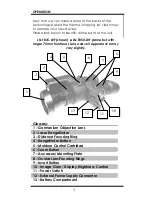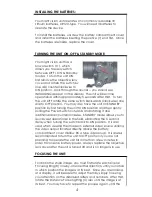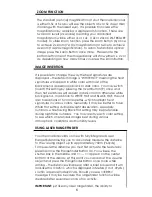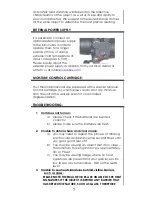
8
YOU WILL NOT BE ABLE TO SPOT PEOPLE INSIDE A VEHICLE
UNLESS THE WINDOWS ARE LOWERED DOWN, OR A
PERSON STANDING BEHIND THE WINDOW IN A HOUSE OR
IN SIMILAR SITUATIONS. LIKEWISE YOU WILL NOT BE ABLE
TO SEE ANY HEAT SIGNATURES WHILE OBSERVING FROM
BEHIND A WINDOW – YOU MUST HAVE UNOBSTRUCTED
VIEW.
NEVER:
1.
Point this device directly at the sun or any heat source
over 500 degrees Celsius (930 degrees Fahrenheit)
2.
Try to disassemble the unit by yourself or by anyone
who is not our authorized technician. Doing so may
result in injury and will void any warranty claims.
3.
Look at the sun through this unit.
4.
Leave the batteries inside the unit for a long period of
time – the batteries may overheat and may render the
unit inoperable and will void the warranty.
5.
Submerse the unit into water or use during heavy rain.
TECHNICAL SPECIFICATIONS:
Imaging Sensor__________ ULIS Pico384 (384x288) 17µm
Frame Rate ______________________ 50 Hz (Shutter-free)
Optical Magnification______________________3.5x (5.0x)
Digital Zoom _________________________________ 2x & 4x
Focusing Distance____________________________ 3m - ∞
Objective Lens Aperture_______________ 50mm (75mm)
Field Of View______________________________ 6.2° x 4.6°
Diopter Adjustment______________________/- 4
Eye base adjustment_________________ 58mm – 72mm
Detection range (1.8m object)_________1200m (1700m)
Power Supply_______________________ 3 x CR123 Lithium
Working time ________________________________ 4.5-5hrs
Temperature Range:
CR123 Batteries______________-10C / +50C (14F – 122F)
Dimensions________________165mm x 139mm x 66mm
Weight_______________________________________ 1400g
LUNA OPTICS, INC.
300 Hawthorn Dr. Fate, TX 75087 (USA)
Tel: +1-972-722-1100; Fax: +1-844-273-3079;
E-mail:
Web:
www.lunaoptics.com
© 2017























